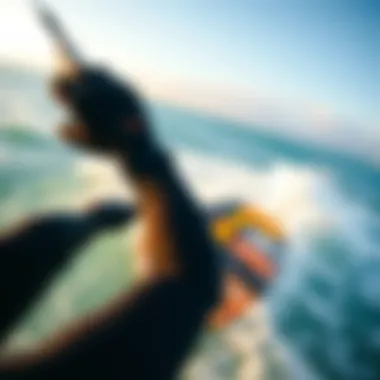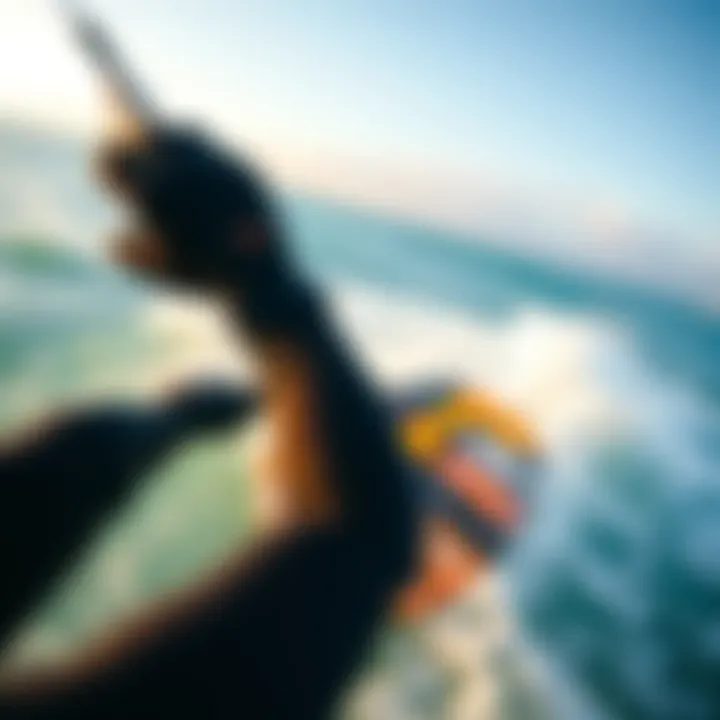Wetsuit Mittens: Key Gear for Kiteboarding


Intro
Kiteboarding is an exhilarating sport that combines the thrill of surfing with the artistry of wind power. As any avid kiteboarder can tell you, the right gear makes a significant difference in performance and comfort. Among this essential gear, wetsuit mittens often fly under the radar, yet they play a critical role in ensuring that kiteboarders are both comfortable and safe while out on the water.
When you’re zipping across the waves at high speeds, the last thing you want to worry about is cold or unprotected hands. Wetsuit mittens help bridge that gap, providing insulation and a snug grip on the control bar. The materials used, the fit, and the specific designs can greatly alter how efficient your movements are and how well you can control your kite during various conditions.
This article aims to explore the ins and outs of wetsuit mittens, providing a comprehensive resource tailored for kiteboarding enthusiasts. Whether you're a seasoned pro or a beginner just cutting your teeth in this fantastic sport, understanding the functionality and significance of your mittens can elevate your experience. With the right pair, you not only optimize your performance but also enhance your comfort during those long sessions on the water.
Preamble to Wetsuit Mittens
Wetsuit mittens often slide under the radar when kiteboarders gear up for a day on the waves. Yet, their role is pivotal. These mittens aren't just about keeping your hands warm; they're about improving grip, enhancing comfort, and even promoting safety. In many situations, kiteboarding enthusiasts find themselves battling the elements. Cold water can sap energy and limit your ability to maneuver your board effectively. This is where the right pair of wetsuit mittens can make a world of difference in maintaining control and overall performance.
Purpose and Functionality
Understanding the purpose of wetsuit mittens can steer you in the right direction when choosing your gear. At first glance, they may seem like just another accessory, but they offer more than just thermal protection. The primary functionality lies in their ability to keep your hands insulated from frigid waters, which can be particularly brutal during those early spring or late fall kiteboarding sessions. Moreover, the material used in wetsuit mittens, often neoprene, allows for a degree of flexibility and tactile feedback that is crucial when managing the lines of your kite.
What you’ll typically find in these mittens is a snug fit that ensures warmth without sacrificing dexterity. The right mittens provide enough grip to hold onto your kite's bar and give you that responsive feel, similar to a second skin. By maintaining dexterity, these mittens can allow you to perform delicate maneuvers while still shielding your hands from the bite of the cold.
Importance in Kiteboarding
Now, consider the importance of wetsuit mittens specifically in kiteboarding scenarios. When you’re out on the water, the experience can range from thrilling to exhausting, depending on the weather. Kiteboarders regularly face the harsh reality of wind and waves that can chill you to the bone, particularly if you're splashing about in colder tides.
Without mittens, kiteboarders might find their circulation limited, cramping their ability to execute jumps or other maneuvers. Most importantly, a good pair of mittens can bolster your confidence. Knowing your hands are well protected allows you to push your limits in ways that poor thermal protection could hinder. These mittens become an essential part of your kit, assuring you that your focus can remain on the thrill of the ride rather than on the discomfort of the biting cold.
"Wetsuit mittens are not merely optional; they are integral to a kiteboarder's experience, striking a balance between comfort and performance in the water."
Equipping yourself with the right gear means ensuring your safety and performance is optimized during your kiteboarding adventures. Pay attention to the need for proper mittens tailored to your personal kiteboarding style and the conditions you face. This understanding will undoubtedly contribute to a more enjoyable ride on the waves.
Types of Wetsuit Mittens
Choosing the right type of wetsuit mitten can significantly influence your kiteboarding experience. The variety available not only helps in personalizing your gear but also caters to specific weather conditions and water environments. Here, we dissect the common categories of wetsuit mittens, providing insights into their unique features, practicality, and the ways they enhance performance on the water.
Full-Mitten Vs. Half-Mitten
Full-mittens cover the entire hand, providing comprehensive warmth. Ideal for chilly waters, they are a boon for kiteboarders who frequent locations with colder climates. The snug fit ensures that minimal water enters, retaining heat better while you glide through the waves.
On the flip side, half-mittens, or split-finger mittens, present a different kind of advantage. They allow a bit more dexterity, making it easier to grip your control bar and perform intricate maneuvers. This middle ground offers warmth while maintaining functionality.
Consider these points:
- Full-Mittens: Great for thermal protection but may sacrifice some hand movement.
- Half-Mittens: Strikes a balance between warmth and mobility, making them suitable for various conditions.
Fingerless Mittens
Fingerless mittens cater to a very specific need among kiteboarders. They offer the benefits of warmth while maximizing tactile feedback. This design is also favored by riders who prioritize control and grip over total warmth. These mittens allow your fingers to move freely, which can be crucial when controlling equipment in gusty winds.
Pros:
- Enhanced dexterity for better control.
- Ideal for warmer climates or transitional seasons.


Cons:
- Reduced warmth, which may not suit colder water conditions.
These mittens are perfect for those who enjoy kiteboarding in milder conditions when the need for thermal protection is less of a priority.
Thermal vs. Non-Thermal Options
When evaluating wetsuit mittens, distinguishing between thermal and non-thermal options is crucial. Thermal mittens are constructed with thicker neoprene or additional insulation to retain body heat effectively. This is essential for prolonged exposure to cold water, reducing the risk of cold-induced issues like numbness and loss of dexterity.
Conversely, non-thermal options are generally lighter and may feature ventilated designs. They are optimal for warmer water conditions or for kiteboarders who prefer to keep their hands cooler during intense sessions.
Consider your typical riding conditions:
- Thermal: Best for those who tackle harsh waters
- Non-thermal: Better suited for casual rides in the sun
Understanding these differences helps in selecting mittens that not only keep you comfortable but also enhance your performance in the water.
Material Considerations
When it comes to wetsuit mittens, the material truly shapes not only the performance but also the durability and comfort of these essential gear for kiteboarding enthusiasts. Kiteboarding often exposes riders to chilly waters and harsh conditions, making it critical to select the right material for optimal protection and flexibility. Let's dive into the two main materials widely used—neoprene and alternatives—to unpack their benefits and considerations.
Neoprene: Pros and Cons
Neoprene is the most common material for wetsuit mittens. It's a synthetic rubber that offers excellent insulation against cold water, making it a go-to choice for avid kiteboarders, especially in colder seasons. Here are the key points regarding neoprene:
- Insulation: Neoprene retains body heat effectively, keeping your hands warm during lengthy rides in frigid waters.
- Flexibility: This material provides a good balance of flexibility and structure, allowing for a decent grip on the kite lines.
- Water Resistance: Its water-resistant nature limits water entry, ensuring that your hands stay dry and comfortable.
However, there are downsides to consider:
- Weight: Neoprene can feel heavy when wet, which might hinder some users’ agility in maneuvering.
- Durability: While it generally holds up well, neoprene can succumb to punctures and wear over time, especially if not treated with care.
- Environmental Issues: The production of neoprene has raised concerns over its environmental impact, as it involves toxic chemicals and petroleum-based ingredients.
All in all, neoprene remains a solid choice, balancing warmth and durability, but be aware of its drawbacks.
Alternative Materials
As kiteboarding evolves, so do the materials that gear manufacturers use. While neoprene has long been a staple, alternative materials are becoming more popular. These options may include items like:
- Titanium Coated Neoprene: This variation features a titanium layer that increases warmth without adding excess weight.
- Spandex Blends: Combining spandex with neoprene or other materials can enhance flexibility and comfort without sacrificing warmth.
- Eco-friendly Materials: Brands are developing sustainable alternatives, like natural rubber and recycled materials, offering kiteboarders a greener choice.
Choosing alternative materials might offer benefits - like improved mobility and lower environmental impacts. However, they may sometimes fail to provide the same level of thermal insulation as traditional neoprene.
For more comprehensive information about materials used in wetsuits, you can refer to resources such as Wikipedia or explore kiteboarding forums on Reddit for user experiences and suggestions.
Sizing and Fit
Getting the right sizing and fit for wetsuit mittens is crucial for kiteboarding enthusiasts. When you're zooming across the water, the last thing you want to deal with is discomfort caused by ill-fitting gear. Whether you're a seasoned rider or just starting, the right fit affects performance, warmth, and even safety.
Measuring for the Right Fit


When it comes to measuring for the right fit, it’s like finding a needle in a haystack if you don’t know what to look for. Here’s a simple approach:
- Hand Measurement: Start by measuring your dominant hand’s width and length. Use a tape measure and wrap it around the widest part of your palm. For length, measure from the tip of your longest finger to the base of your hand. Taking these measurements gives you a solid foundation when referring to size charts.
- Refer to Size Charts: Every brand has its own sizing chart, which is often available on their website. Once you have your measurements, compare them against the chart. Brands like O’Neill and Billabong offer comprehensive sizing guides that can help you nail the right size. Keep in mind that some might suggest a snug fit, while others prefer a looser style based on what feels best for the wearer.
- Try Before You Buy: If you can, it’s always best to try on the mittens before purchasing. Many local shops allow for this. You’ll want to see if you can flex your fingers inside the mittens comfortably. They should feel snug without cutting off circulation.
"A well-fitting mitten should feel like a second skin, aiding your grip and dexterity while kitesurfing."
Taking the time to measure properly pays off in the long run, ensuring that your hands stay warm and functional during every ride.
Common Sizing Errors
Even the most experienced kiteboarders can fall prey to common sizing errors. These pitfalls can range from minor annoyances to significant performance issues. Let’s highlight a few:
- Ignoring Brand Variations: As mentioned, sizing can vary between brands. Just because you wear a medium in one brand, doesn’t mean you’ll fit in medium for another. Always double-check!
- Focusing only on Width: While palm width is important, measuring your fingers' length is equally essential. If the fingers are too long or short, it can make gripping tricky.
- Settling for an Overly Loose Fit: Some might think that a looser fit allows for better movement. However, it can actually lead to cold water slipping in, leaving your mittens ineffective against the chill.
- Neglecting Activity Level: If you're a more aggressive kiteboarder, you'll likely need a specific fit that allows for dynamic movements. Don't just stick to what looks good; assess what feels functional too.
By being cognizant of these common mistakes, you can avoid unnecessary discomfort and ensure that your wetsuit mittens truly serve their purpose. The right fit not only enhances performance but also boosts your confidence out on the water.
Performance Under Different Conditions
When it comes to kiteboarding, having the right gear can make all the difference. Wetsuit mittens are not just another accessory; they are crucial for comfort and safety under varying environmental conditions. Understanding how these mittens perform in different weather scenarios can help enthusiasts maximize their experience on the water. The temperature of the water, the air, and wind conditions all play pivotal roles in the selection of mittens, making it essential for kiteboarders to assess these factors carefully before heading out.
Cold Water Conditions
Cold water can be unforgiving. When the temperature dips, it's not just about keeping your body warm; it's about maintaining dexterity. Wetsuit mittens designed for cold conditions usually come with thicker materials, often with varying densities of neoprene, providing sufficient insulation to stave off the bone-chilling effects of frigid water.
For instance, when the water is hovering at a brisk 50 degrees Fahrenheit, even the most seasoned kiteboarder can find their fingers sluggish and unresponsive, affecting overall control. The mittens should fit snugly yet allow for some movement, ensuring a balance between warmth and tactile feedback. Look for mittens with a smooth skin exterior, as they also help to reduce water entry, keeping your hands warmer for longer.
Proper fit is critical; too tight can restrict circulation, and too loose defeats the purpose of insulation.
Warm Water Conditions
While warm waters might sound ideal, they come with their own set of challenges. As temperatures rise, kiteboarders need to consider not just the heat but potential UV exposure. Lightweight, breathable mittens can protect sensitive skin while enabling sufficient airflow to keep hands dry. Sandwiching a layer of UV-resistant material with neoprene can serve two purposes: enjoy abrasion protection while preventing sunburn.
In certain regions, especially tropical locales, the use of fingerless mittens can enhance grip while still offering some thermal protection against splashes. This design maintains agility, allowing kiteboarders to grab their lines or make quick adjustments easily.
Windy Conditions
Wind conditions are often the wildcard in kiteboarding. High winds can create chop on the water, which sometimes turns it into a battleground. Kiteboarders need mittens that can handle not only the chill from the wind but also the increased force against their hands. The ideal mittens for such days will provide not only warmth but also excellent grip to handle the bar securely, which can be challenging when gusts kick in.
Desirable features might include textured palms and reinforced finger areas, ensuring that your control isn’t compromised even in squally scenarios. Pay attention to cuff design as well; a tighter cuff can prevent wind infiltration.
Ultimately, mittens tailored to specific conditions can elevate a kiteboarder's ride, ensuring both comfort and safety are maintained. Don’t overlook the importance of choosing the right pair for the environment you’re in—this could be the key to enjoying your time on the water.
Maintenance and Care
Maintaining your wetsuit mittens is essential for prolonging their lifespan and ensuring they perform optimally when you hit the water. It’s easy to overlook the care these items require, especially when you're excited about kiteboarding. However, just as you wouldn’t neglect your kite or board, caring for your mittens is vital. Proper maintenance detracts the build-up of salt, sand, or other debris, which can degrade the material over time. Keeping your gear in tip-top shape allows you to maintain comfort and grip during your sessions.
Proper Cleaning Techniques
When it comes to cleaning wetsuit mittens, the primary rule is to wash them after each use. This simple step prevents buildups of salt and grime, which can swiftly ruin the fabric. Here’s how to do it right:


- Rinse immediately: As soon as you’re done, rinse your mittens with fresh water. This helps to wash away any salt and keeps them from stiffening up.
- Use mild soap: Occasionally, it’s good to give them a proper bath using a gentle neoprene cleaner. Harsh detergents can cause the material to break down.
- Avoid machine washing: Do not toss them in the washing machine. The agitation and high temperatures can deform the mittens.
- Hang dry: Always hang them to dry, away from direct sunlight, as UV rays can quickly deteriorate the material.
Storage Tips
Storage plays a crucial role in maintaining the integrity of your mittens. Improper storage can lead to deformities or damage over time. To avoid common pitfalls, keep the following pointers in mind:
- Store flat: Don’t fold your mittens; rather, lay them flat or hang them. Crumpling or folding can create creases that become permanent.
- Avoid heavy stacking: If you store gear on top of each other, ensure not to pile heavy items on your mittens. This can cause dents and affect their performance.
- Keep in a cool place: Avoid areas with high heat or humidity, which can lead to mold or mildew. A well-ventilated space is best.
Signs of Wear and When to Replace
Over time, even the best-made wetsuit mittens wear out. Recognizing the signs of decay is pivotal for maintaining safety and performance. Here are some indicators that it may be time to replace your mittens:
- Cracks or tears: If you see visible cracks or tears, this is a clear sign they’re no longer effective.
- Loss of insulation: If your hands feel cold even when wearing them, it could indicate that the thermal properties have degraded.
- Fading color: While aesthetics aren’t everything, fading can indicate UV or environmental damage, suggesting it’s time for a new pair.
Proper maintenance of wetsuit mittens not only protects your investment but also enhances your kiteboarding experience by ensuring your gear is always ready to perform.
For more insights on the care of your gear, check out Britannica and Reddit. These platforms often share user experiences and practical tips that can help you maximize your gear care knowledge.
Comparative Analysis
When diving into the realm of wetsuit mittens, a comparative analysis serves as a crucial guide for kiteboarding enthusiasts. It's not merely about choosing a pair of mittens; it's about understanding how different brands and types can enhance your performance on the water.
A thorough comparison allows riders to weigh the pros and cons based on various criteria such as material, design, and fit. Factors such as durability and thermal protection can greatly influence one’s experience in diverse conditions. The right choice can make the difference between a comfortable session and one filled with numbing cold or poor grip.
Best Brands in Wetsuit Mittens
The market for wetsuit mittens hosts a variety of brands, each vying for attention with their unique offerings. Some of the most reputable names include:
- Manera: Known for innovative designs, their mittens often prioritize flexibility without sacrificing insulation.
- O'Neill: A staple in water sports, O'Neill produces mittens that blend warmth with comfort. Their easy-on features often make them a go-to for many.
- Prolimit: Geared towards performance, Prolimit generates mittens designed for durability and a tight fit, making them popular among serious kiteboarders.
These brands not only come with their own set of features and price points but also reflect different user preferences and environmental adaptations. Evaluating these factors can help kiteboarders choose mittens that align with their specific needs.
User Reviews and Testimonials
When assessing any gear, user reviews and testimonials provide invaluable insights. They offer a lived experience that can often resonate more than marketing claims. Here's what some kiteboarders are saying about their wetsuit mittens:
"I loved my Prolimit mittens for a winter session. Kept my hands warm and flexible for longer rides!"
From practical observations about fit and comfort to the mittens’ resilience in harsh conditions, users report a variety of experiences. Key points gathered from reviews include:
- Thermal Efficiency: Riders consistently note how crucial it is for mittens to maintain warmth without compromising agility.
- Durability: Long-term users emphasize the wear and tear, with high-quality mittens lasting multiple seasons while lesser-quality pairs fall apart quickly in active use.
- Comfort Fit: Many reviews highlight the importance of a snug yet comfortable fit, which can significantly impact overall performance.
In synthesizing these insights with comparative analysis, kiteboarders can make informed decisions, matching their personal preferences with what others have found effective. This approach leads to a more gratifying kitesurfing experience.
Culmination
Wetsuit mittens are more than just an accessory for kiteboarding enthusiasts; they play a critical role in enhancing both comfort and performance on the water. Understanding their functionality, types, and care methods is essential for anyone serious about kiteboarding. As this article has illustrated, the right pair of mittens can greatly influence your experience when faced with varying weather conditions, whether the waters are frigid or simply brisk.
Investing in quality wetsuit mittens can make the difference between a brief, enjoyable session on the water and a long, challenging trek back to shore when temperatures dip to uncomfortable levels. Not only do they offer thermal insulation, but they also protect against wind chill and solar exposure. In essence, they serve as the first line of defense against nature's elements, allowing kiteboarders to focus on their performance rather than their comfort.
Equally important is the comparative analysis provided in this guide, highlighting leading brands and user experiences. It becomes abundantly clear that not every mitten is created equal. Exploring various options helps to fine-tune personal preferences and performance needs, thereby ensuring each kit is tailored for success.
In summary, the insights shared in this article are aimed at empowering kiteboarders to make informed decisions about their gear. Choosing the appropriate wetsuit mittens, considering aspects like material and fit, ultimately enhances the overall kiteboarding experience. A smart selection today leads to better performance and safety in the future. As the famous saying goes, "An ounce of prevention is worth a pound of cure."
"Quality gear is not just about comfort; it’s about enabling adventure without the distraction of discomfort."
By remembering these essential points, kiteboarders can look forward to many enjoyable rides ahead, unburdened by chilly fingers or improper fit. So gear up, get out there, and ride the waves with confidence!















